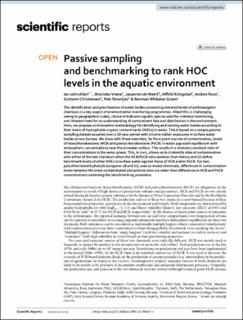| dc.contributor.author | Allan, Ian John | |
| dc.contributor.author | Vrana, Branislav | |
| dc.contributor.author | de Weert, Jasperien | |
| dc.contributor.author | Kringstad, Alfhild | |
| dc.contributor.author | Ruus, Anders | |
| dc.contributor.author | Christensen, Guttorm | |
| dc.contributor.author | Terentjev, Petr | |
| dc.contributor.author | Green, Norman Whitaker | |
| dc.date.accessioned | 2022-01-18T12:39:54Z | |
| dc.date.available | 2022-01-18T12:39:54Z | |
| dc.date.created | 2021-12-13T09:38:23Z | |
| dc.date.issued | 2021 | |
| dc.identifier.citation | Scientific Reports. 2021, 11, 11231. | en_US |
| dc.identifier.issn | 2045-2322 | |
| dc.identifier.uri | https://hdl.handle.net/11250/2837940 | |
| dc.description.abstract | The identification and prioritisation of water bodies presenting elevated levels of anthropogenic chemicals is a key aspect of environmental monitoring programmes. Albeit this is challenging owing to geographical scales, choice of indicator aquatic species used for chemical monitoring, and inherent need for an understanding of contaminant fate and distribution in the environment. Here, we propose an innovative methodology for identifying and ranking water bodies according to their levels of hydrophobic organic contaminants (HOCs) in water. This is based on a unique passive sampling dataset acquired over a 10-year period with silicone rubber exposures in surface water bodies across Europe. We show with these data that, far from point sources of contamination, levels of hexachlorobenzene (HCB) and pentachlorobenzene (PeCB) in water approach equilibrium with atmospheric concentrations near the air/water surface. This results in a relatively constant ratio of their concentrations in the water phase. This, in turn, allows us to (i) identify sites of contamination with either of the two chemicals when the HCB/PeCB ratio deviates from theory and (ii) define benchmark levels of other HOCs in surface water against those of HCB and/or PeCB. For two polychlorinated biphenyls (congener 28 and 52) used as model chemicals, differences in contamination levels between the more contaminated and pristine sites are wider than differences in HCB and PeCB concentrations endorsing the benchmarking procedure. | en_US |
| dc.language.iso | eng | en_US |
| dc.publisher | Nature | en_US |
| dc.rights | Navngivelse 4.0 Internasjonal | * |
| dc.rights.uri | http://creativecommons.org/licenses/by/4.0/deed.no | * |
| dc.title | Passive sampling and benchmarking to rank HOC levels in the aquatic environment | en_US |
| dc.type | Peer reviewed | en_US |
| dc.type | Journal article | en_US |
| dc.description.version | publishedVersion | en_US |
| dc.rights.holder | © Te Author(s) 2021 | en_US |
| dc.source.pagenumber | 12 | en_US |
| dc.source.volume | 11 | en_US |
| dc.source.journal | Scientific Reports | en_US |
| dc.identifier.doi | 10.1038/s41598-021-90457-3 | |
| dc.identifier.cristin | 1967597 | |
| dc.source.articlenumber | 11231 | en_US |
| cristin.ispublished | true | |
| cristin.fulltext | original | |
| cristin.qualitycode | 1 | |

